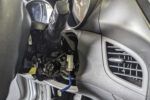Is California’s high-speed rail plan a pipe dream?
Construction workers inside the Fresno Trench, a portion of the high-speed railway being built in Fresno, California, on May 8, 2019 (Frederic J. BROWN)
Fresno (United States) (AFP) – Keith Erwin was about to buy the land that his auto repair shop sits on when he was turned down because California’s much awaited high-speed rail line was going to pass through the spot.
Five years later, he sees no train coming anytime soon and no longer believes in it.
“It’s a train that’s going to go nowhere,” the mechanic said at his garage in Fresno, just steps from where the train is supposed to eventually pass.
Even though construction is well underway in Fresno, Erwin insisted: “I think they’re out of money. I don’t think they’re going to build it at all from what we see.”
In February, newly elected Governor Gavin Newsom announced he was drastically revising downward the high-speed rail project to link Los Angeles to San Francisco in three hours, even though the plan was approved in a 2008 referendum.
The federal government indicated Thursday it was scrapping a $900 million subsidy due to “chronic” construction delays.
A growing chorus of critics and multiple court challenges set back the project, and construction only began in 2015.
Train travel has not been popular in this sprawling state — the most populous in the country — where the car is king.
While many countries began providing high-speed rail starting in the 1980s, California kept investing in road infrastructure.
“The culture of the state itself has really been about our vehicles and our cars… but now that’s changing,” California High Speed Rail regional director Diana Gomez told AFP.
Her group is responsible for creating, building and implementing the project.
She noted that younger generations now want to use public transportation and are placing their bets on high-speed rail, which is better for the environment.
– Minimalist solution –
Traveling the 380 miles (600 kilometers) that separate Los Angeles from San Francisco takes at least six hours by car.
It’s only an hour by plane but chronic traffic jams to get to the airport followed by security checks make the three-hour train journey an appealing solution for many travelers.
“But let’s be real. The project, as currently planned, would cost too much and take too long. There’s been too little oversight and not enough transparency,” Newsom said in his State of the State address in February.
“Right now, there simply isn’t a path to get from Sacramento to San Diego, let alone from San Francisco to LA. I wish there were.”
The project budget has jumped 20 percent over initial estimates, to reach $77 billion.
But California is not giving up on what critics call the “train to nowhere.” Newsom said focus would now be on a section of the corridor that’s only about a third of the total distance, linking Merced and Bakersfield, with Fresno at the halfway point.
Industry watchers say the reduced ambitions are a mistake.
“It absolutely does not make sense,” said Anastasia Loukaitou-Sideris, an urban planning professor at the University of California, Los Angeles (UCLA).
“Any transit project needs big (urban) centers as origins and destinations, and so to have something like that… all but kills the project.”
Gomez, however, sees the short link as just the beginning.
“Once people see high speed rail running, then you know there will be more support for it to continue,” she said.
“We have enough funds to build this segment up so let me do that and then continue working on the environmental documents for the rest of the state.”
There are many obstacles, including procedures for expropriation of land that have proven far more complicated than anticipated.
“It was chaos getting moved,” said Erwin, the mechanic, noting that staff at the project kept quitting or getting fired.
“Unorganized people didn’t know what they were doing… It was just a big mess and it still is.”
Martin Wachs, a UCLA professor emeritus of urban planning, said California should have capitalized on its existing rail network, including that currently dedicated to freight.
“What I would have recommended at the time was to improve the service along those routes gradually, building more patronage for rail and making it more politically popular by virtue of having more people and then extending that system until the point where we had genuine high speed rail,” he said.
Instead, authorities treated the high speed rail as a separate program from the rest of California’s rail systems.
The first train is not expected to travel through Fresno for another decade at best.
And even if that happens, “I won’t ride it,” snorted Erwin.
Disclaimer: Validity of the above story is for 7 Days from original date of publishing. Source: AFP.


